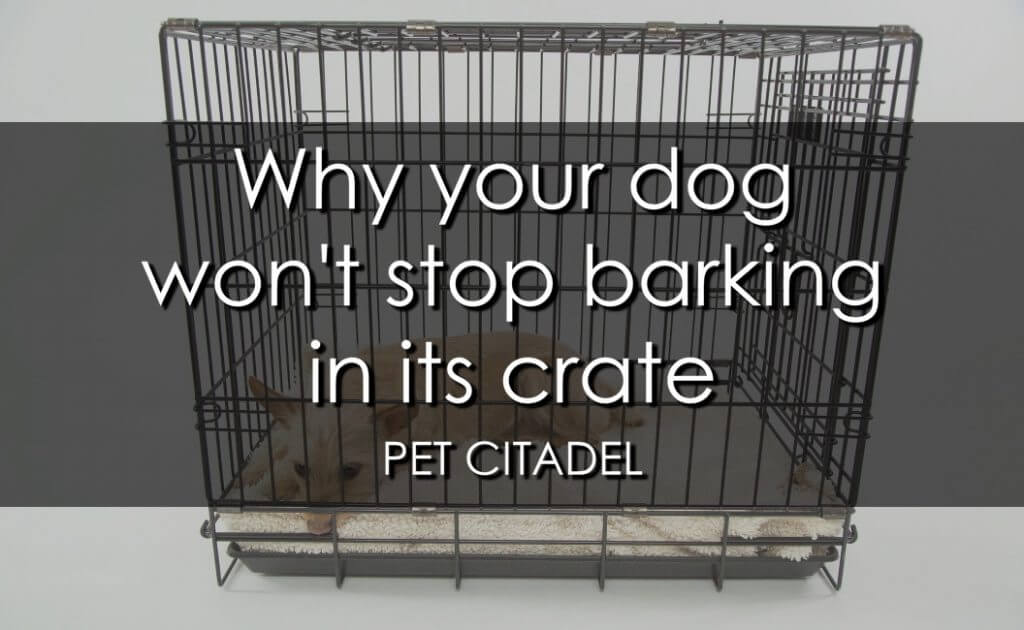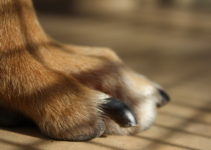This post may contain affiliate links. You can view our affiliate disclosure here.

When you adopt a dog, you probably have certain expectations, and sleepless nights are not one of them. If you find that your dog or puppy won’t stop barking in its crate, or if it barks every time you leave home, you may be desperate for a solution.
Whether you use the crate at night or when you leave home to prevent destruction or accidents, you may want to know what you can do to stop the barking. Thankfully, you have options!
In our view, the best strategy is to make the crate a calm and pleasant place in order to prevent the barking altogether.
Causes Of Barking In The Crate
Barking in the crate is incredibly annoying, and can even be a nuisance to your neighbors if you let it continue uninterrupted. But, with some understanding and training on your part, you can bring that barking to an end.
Before we get to solutions for stopping the barking, let’s briefly go over the four most common causes:
1. Separation Anxiety

Separation anxiety is one of the most common causes. This results when separating from your dog causes it distress.
When you leave, your dog no longer feels safe and as a result, it may desperately try to get back to you. This includes barking or whining to get you to open the crate.
2. Negative Association
If you have previously used the crate as a place of punishment or if you have ever forced your dog into the crate, it’s likely that it will associate the crate with a negative experience and believe that the crate is a bad place.
This needs to be corrected before you can get your dog to stop protesting when you so much as look at the crate.
3. Boredom

If you aren’t putting anything in the crate with your dog and expect it to sit inside all day long, they are going to get bored.
This can be a big problem, but it has a simple fix — simply provide your dog with some stimulation in the crate, such as a durable chewing toy.
4. Your Dog Knows It Works
Perhaps the most insidious cause is that you’ve shown your dog that its barking gets it what it wants.
If you have given in to your dog in the past, such as by opening up the crate to let it out, your dog will continue to bark because it understands that you’ll acquiesce when the barking becomes too much.
Promoting Positive Association With The Crate
There’s good news: if you have taught your pup to hate the crate, or if you’ve never properly crate trained in the first place, you have a relatively easy fix on your hands.
The first thing you should seriously consider doing, especially if you have a puppy, is read our guide on crate training.
Otherwise, you simply make the crate a place that your dog enjoys being in. To achieve this, do the following:
1. Avoid punishment in the crate.
The most important thing to remember is that the crate is not meant to be a punishment. You want to avoid all negative experiences and associations with the crate.
In fact, punishment should not be a part of your dog-training vocabulary at all! Redirection and positive reinforcement are almost always more effective.
2. Give high-value treats in the crate.

You also want to make sure that your dog sees the crate as somewhere that it wants to be. This includes providing high-value treats when your dog enters the crate. Your dog will begin to associate the crate with the treats as well.
You can also put treats through the top of the crate all of a sudden to try to promote a fun, playful atmosphere. Doing so helps your dog see that good things happen when it’s in the crate.
Have specific treats and toys that the dog only gets in the crate, and you’ll see it start to look forward to crate time instead of barking.
3. Use the crate even if you’re not leaving.

If separation anxiety is the cause of your dog’s barking, the best thing that you can do is make sure that your dog doesn’t think that the crate is always a precursor to you leaving or being away.
By putting your dog in the crate at random, you prevent the association of only using it as you’re walking out the door. This unpredictability allows your dog to relax more when you do have it go into the crate.
4. Create a schedule to stop night barking.
If your problem is your dog barking at night, the best thing you can do is create a schedule. Have a routine that you follow so your dog knows that at night, it’s bedtime.
By following the same routine of a bathroom break, a certain treat, and being put in the crate at the same time every night, your dog will learn that you expect it to be quiet and sleep at night. The key here is consistency.
5. Ignore the barking.
One final effective method you can employ is to ignore your dog’s barking as much as possible. This is even more likely to be effective if you’ve responded to your dog’s crate barking in the past, which itself can cause all sorts of problems.
Teach your dog that you do not respond to barking; this means no eye contact, no telling it to be quiet repeatedly, and most importantly, no letting it out of the crate!
After a few days, your dog will start to learn that barking won’t result in it being let out of the crate.
Conclusion
To sum up, you first need to understand why your dog is barking in its crate. Make sure it’s not a serious issue that your dog is alerting you to such as a fire or break-in.
The next step is to implement a solution, depending on what the cause of the barking is.
Keep in mind that when trying to change a behavior like barking, you may very well experience an “extinction burst”, meaning the barking will get worse before it gets better. In the majority of cases, it will take time and effort before you begin to see positive results.
Having said all this, sometimes, you won’t be able to stop the barking despite your best efforts. In these cases, your dog may need professional help.
You could get the advice of a professional behaviorist or the help of a dog trainer. But professional dog trainers can be extremely expensive, charging several hundred dollars per hour. Not many dog owners can afford this kind of expense.
There’s a solution. You can get instant access to a dog training program by a certified dog trainer with over a decade of experience working with clients.
This trainer has figured out that barking issues fundamentally come down to learning how to calm your dog down and help it regain control of its emotions.
And so he’s put together a series of emotional control exercises that have been proven to overcome barking in crates and other barking issues.
This dog training package is substantial, and it costs a tiny fraction of what you would pay for the services of a typical dog trainer or behaviorist.
You can alternatively read my review of the program.
Best of luck in correcting your dog’s barking problem!
Thanks for reading this article. Do you have problems with your dog barking in its crate? Feel free to share your experiences or ask questions in the comments below.




